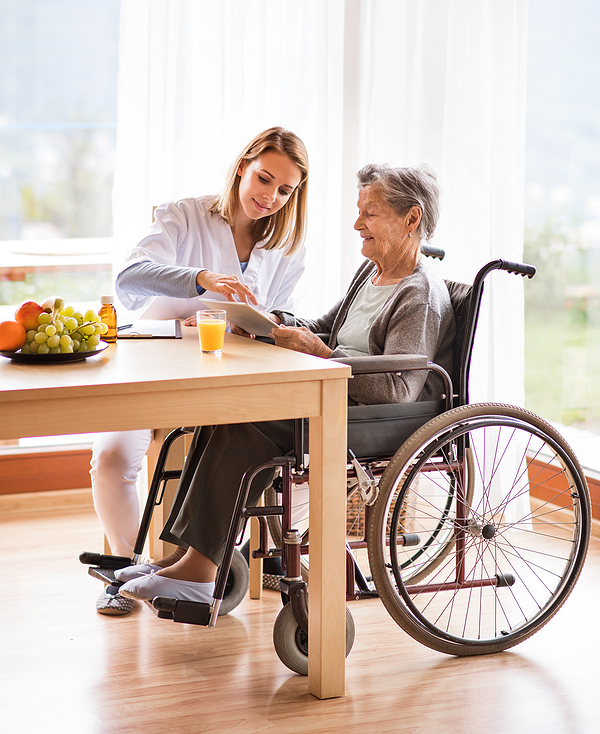There’s a lot to prepare for when you begin taking care of elderly parents at home. Here are our best tips to set yourself up for success.
1. Understand Your Parents’ Needs
Before taking care of your elderly loved ones at home, it’s important to assess your parents’ health and daily living needs. Review their medical conditions, mobility issues, dietary needs, and daily routines. Consider questions such as whether they’re relatively independent or require help with activities like bathing, eating, or getting around? Knowing this information will help you plan better for their care and create a supportive environment that fits their needs.
2. Create a Safe and Accessible Environment
Modify your home to make it safe and accessible. Consider installing grab bars in the bathroom, securing loose rugs to prevent trips, and rearranging furniture to create clear walking paths. Remember, a well-organized space isn’t just about safety; it’s about creating a welcoming environment in which your loved one is comfortable.
3. Organize Medical Information
Keep a record of all medical information, including doctor’s contacts, medication schedules, and any important health history. This information is crucial for emergencies and regular check-ups.
4. Set a Daily Routine
Building a daily routine can provide stability and comfort for your elderly parents. A study published in the National Library of Medicine finds it reduces seniors’ anxiety and stress levels. Schedule regular times for meals, medications, activities, social interaction, and rest.
5. Encourage Physical Activity
Depending on their ability, encourage your parents to engage in physical activity. This could be light exercises, walks, or even physical therapy prescribed by their doctor.
6. Foster Social Connections
Social interaction is vital for the mental health of older adults. A Penn State study shows that seniors who have more pleasant social interactions have better cognitive performance surrounding those interactions. Encourage visits from friends and family or help them connect with others through community groups or online platforms.
7. Financial Planning
Taking care of elderly parents at home often comes with financial implications. Create a budget that includes their medical expenses, caregiving supplies, and any home modifications. To ease the financial burden, consider insurance options, government assistance programs, and possible tax deductions. BenefitsCheckup by the National Council on Aging is a great resource to connect you with programs that can help pay for your loved one’s needs.
8. Use Technology and Resources
Technology is ever-changing and can help you when caring for older adults. The help medical alert systems, video monitors, medication dispensing devices, and health tracking apps provide are invaluable. They not only provide safety but also give you peace of mind.
9. Create an Open Line of Communication
Maintain open lines of communication with your parents. Discuss their preferences and listen to their concerns. By doing so, you help them feel respected and involved in their own care. Also, keep in touch with healthcare professionals for regular updates on their health status.
10. Be Patient and Compassionate
You must have patience and compassion when taking care of elderly parents at home. You’ll have challenging days, but empathy and understanding can make a significant difference in your parents’ lives.
11. Take Care of Your Mental Health
Caring for older adults is often emotionally taxing and demands patience, empathy, and resilience. Your health is just as important as your parents’. Prepare yourself mentally for the challenges ahead. Seek support groups or counseling to manage stress and emotions. Make sure to take time for yourself, get enough rest, eat well, engage in activities you enjoy, and seek support when needed.
12. Seek Professional Help When Needed
Understand that sometimes, the care needs may become too demanding for you to handle alone. Whether hiring a part-time caregiver or seeking advice from healthcare professionals, don’t hesitate to contact companies like A Place At Home.
Let A Place At Home Help
Taking care of elderly parents at home is a significant commitment and takes planning, patience, and support. Avoid feeling overwhelmed by connecting with our compassionate care team at A Place At Home. We specialize in private care for the elderly at home, providing personalized aid that respects the dignity and independence of your loved ones. Our team can help create a custom care plan from our wide range of services that are tailored to your family’s needs. Whether it’s helping with daily activities, medical care, or simply companionship, we’re here to support you. Visit our website to find a location near you to learn more about how we can guide you through your parents’ aging journey.






 In early March, A Place at Home franchise owners visited their remote staffing solution partner, Solvo Global, in Medellin, Colombia. Multiple A Place at Home franchisees were welcomed to Solvo Global’s headquarters to tour their offices, meet their remote teammates, and learn about each other’s shared passion for helping others.
In early March, A Place at Home franchise owners visited their remote staffing solution partner, Solvo Global, in Medellin, Colombia. Multiple A Place at Home franchisees were welcomed to Solvo Global’s headquarters to tour their offices, meet their remote teammates, and learn about each other’s shared passion for helping others.


